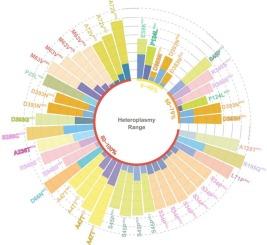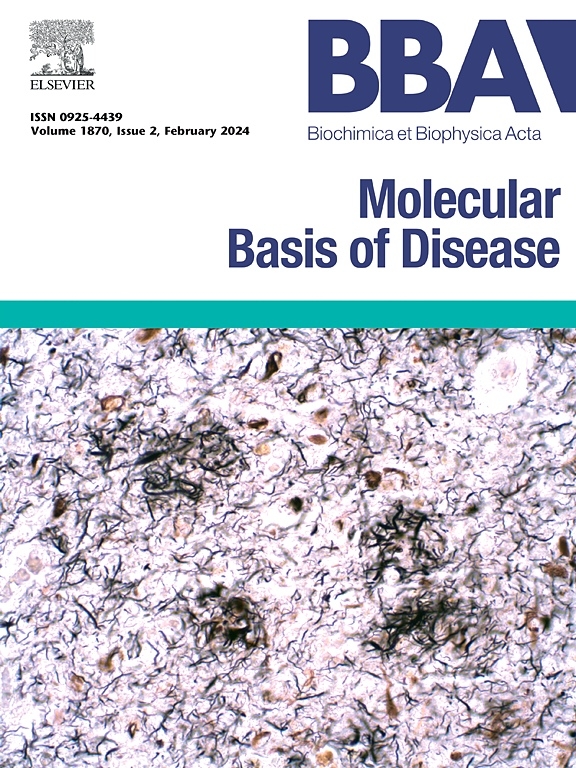遗传性线粒体疾病的基因型/表型难题:来自复杂I中与Leigh综合征相关的mtDNA突变调查的见解
IF 4.2
2区 生物学
Q2 BIOCHEMISTRY & MOLECULAR BIOLOGY
Biochimica et biophysica acta. Molecular basis of disease
Pub Date : 2025-07-25
DOI:10.1016/j.bbadis.2025.167996
引用次数: 0
摘要
线粒体疾病包括广泛的遗传性疾病损害线粒体功能。在这些原发性线粒体疾病的诊断和临床管理方面取得了相当大的进展。然而,诊断和治疗在很大程度上仍然是经验性的,因为许多已知突变导致患者特定表型的致病机制仍然知之甚少。为了深入研究线粒体医学的核心挑战,我们对一组已发表的由线粒体基因组编码的呼吸链复合体I亚基点突变引起的Leigh综合征病例进行了重点调查。Leigh综合征是最严重的线粒体疾病之一,以临床和遗传表现为特征,主要影响中枢神经系统和大脑。我们发现,即使是特定分子缺陷与疾病严重程度和进展之间的基本相关性,也常常被现有诊断数据的异质性所掩盖。尽管如此,我们的分析表明,为了了解它所带来的具体致病影响,对于每个突变,必须仔细区分复合体I的哪个功能域实际受到影响。显然,应该对具有代表性的突变进行更全面和差异化的研究,并从患者那里获得更完整和标准化的诊断数据。这将是理解和区分致病机制的先决条件,也是开发有效合理的治疗Leigh综合征和其他线粒体疾病的方法。本文章由计算机程序翻译,如有差异,请以英文原文为准。

The genotype/phenotype conundrum of inherited mitochondrial disorders: Insights from a survey of mtDNA mutations associated with Leigh syndrome in complex I
Mitochondrial disorders encompass a broad spectrum of genetic disorders impairing mitochondrial function. Considerable advancements have been made in the diagnosis and clinical management of these primary mitochondrial diseases. However, diagnosis and treatment have remained largely empirical, because the pathogenic mechanisms are still poorly understood by which any of the numerous known mutations lead to a specific phenotype in patients. To make inroads into this central challenge of mitochondrial medicine, we performed a focused survey of a cohort of published cases of Leigh syndrome caused by point mutations in subunits of respiratory chain complex I encoded by the mitochondrial genome. Leigh syndrome is one of the most severe mitochondrial disorders and is characterized by clinical and genetic manifestations predominantly affecting the central nervous system and the brain. We found that even basic correlations between a specific molecular defect and disease severity and progression are often obscured by the heterogeneity of the available diagnostic data. Still, our analysis showed that in order to understand the specific pathogenic impact it entails, for each mutation one has to carefully differentiate which functional domain of complex I is actually affected. It seems evident that much more comprehensive and differentiated studies of representative mutations as well as far more complete and standardized diagnostic data from patients should be obtained. This will be prerequisite for understanding and discriminating pathogenic mechanisms as a way to develop effective rational therapies for Leigh syndrome and other mitochondrial disorders.
求助全文
通过发布文献求助,成功后即可免费获取论文全文。
去求助
来源期刊
CiteScore
12.30
自引率
0.00%
发文量
218
审稿时长
32 days
期刊介绍:
BBA Molecular Basis of Disease addresses the biochemistry and molecular genetics of disease processes and models of human disease. This journal covers aspects of aging, cancer, metabolic-, neurological-, and immunological-based disease. Manuscripts focused on using animal models to elucidate biochemical and mechanistic insight in each of these conditions, are particularly encouraged. Manuscripts should emphasize the underlying mechanisms of disease pathways and provide novel contributions to the understanding and/or treatment of these disorders. Highly descriptive and method development submissions may be declined without full review. The submission of uninvited reviews to BBA - Molecular Basis of Disease is strongly discouraged, and any such uninvited review should be accompanied by a coverletter outlining the compelling reasons why the review should be considered.

 求助内容:
求助内容: 应助结果提醒方式:
应助结果提醒方式:


